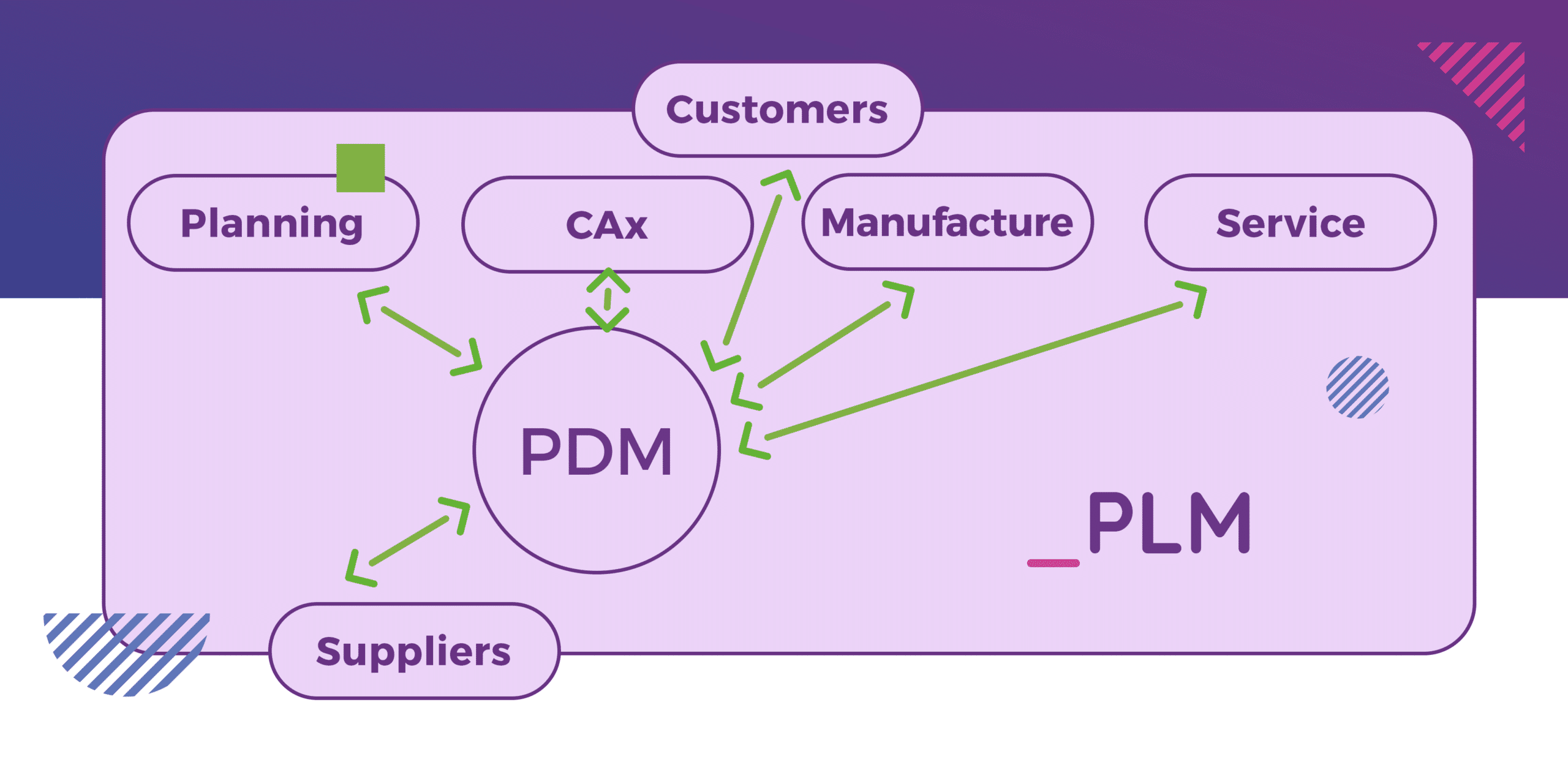Organizations in complex industries, such as automotive and aerospace, have long been developing their advanced products using multiple CAD systems. These systems include mechanical CAD (MCAD) solutions from different providers or systems of different classes, such as MCAD and electrical CAD (ECAD). As a result, these companies are facing the difficult challenge of managing incompatible CAD data. Huge amounts of data are generated during the product development process. In order to shorten the time of implementation and the launch of a new product on the market, members of the implementation team must cooperate and share data all the time, so it is necessary to implement a coherent environment for cooperation, regardless of the type of data. Therefore, companies face the challenge of multi-CAD data management, as well as providing up-to-date and accurate data to those who need it at any given time.
The Importance of CAD
CAD systems are now widely used in almost all industries: automotive and aerospace , architecture and construction, heavy industry and machinery, retail and apparel, consumer goods and so on. Recently, due to the dynamic development and growing popularity of innovative visualization techniques, such as Virtual Reality and Augmented Reality, as well as Rapid Prototyping, the use of CAD systems has been growing steadily. Additionally, users outside of engineering and design need access to CAD data. Integrated data is used downstream by manufacturing, quality, service, and sales and marketing teams. It may even need to be used by customers, and their customers!
CAD systems belong to a wider category of integrated manufacturing systems generally known as CAx (Computer Aided x). In addition to CAD, they include CAE (Computer Aided Engineering) and CAM (Computer Aided Manufacturing) systems. If we look at these systems from a wider perspective, CAx systems integrated with PDM modules are part of PLM systems. All these tools taken together, as a coherent whole, form a source of information about a product throughout its lifecycle and constitute the Product Data Backbone of each organization. Without CAD data, this backbone does not exist.
Data Management Challenges
In order to face the contemporary challenges of the market and global competition, many companies adopt the concepts of an integrated and virtualized environment that contains many CAD systems from different vendors. Users from all over the world create, modify, and save data to one powerful data management system which includes all company products. Companies must manage these huge amounts of data, but how? Implementing the most important assumptions and concepts of modern enterprises requires not only advanced design tools, but also effective product data management. Proper design and implementation of data management processes is also key. Finally, data must be accessible to all participants in the product lifecycle, so that they can use this data at any time and in the right context.
PDM vs PLM in Data Management
If we want to consider the issue of CAD data management, it is essential to introduce the main ideas associated with PDM and PLM systems. These abbreviations are often confused and used interchangeably, even though their meaning differs significantly. Both systems serve similar purposes, but confusion happens when the boundary between them is not clearly defined. PLM systems focus on the entire product life cycle and cover a much wider range of data. PDM systems are most often used to manage 3D models, drawings, and other data created during the design process.
Product data management systems are a consequence of the wide application of CAx systems. They were born out of the need for structured collection, sharing and reuse of huge amounts of valuable data generated during the design process. Product life cycle management (PLM) software, on the other hand, is the next stage of this development and a natural consequence of PDM. While PDM systems are perfectly capable of tracking the life cycle of design documentation and related documents and processes, it is impossible to monitor the entire product life cycle from their level. If there is no information on the current life cycle status of the product in other systems, data stored in the PDM database can quickly become out of date.
PDM is a part of a larger architecture. This architecture covers the entire spectrum of systems used for requirements and project management, product portfolio management or manufacturing process management. PLM combines all of these applications into one coherent, integrated environment. Moreover, unlike PDM, PLM systems also cover stages in the product life cycle that start after leaving the factory, such as field service, withdrawal from use, or environmental aspects. PLM also covers scope that goes beyond the organization itself. For example, managing data related to suppliers or contractors. The PDM system is a part of PLM. PDM supports only product development, but PLM comprehensively supports all activities related to the management of the product life cycle from the moment the idea for a product is conceived to the moment it is withdrawn from use.

Why Windchill for Multi-CAD Data Management?
According to multiple third-party experts, PTC Windchill is the leading system of the PLM class. Windchill architecture is completely network-based, supporting the Design Anywhere, Manufacture Anywhere (DAMA) approach. This ensures that teams located around the world can effectively collaborate and handle all important areas of comprehensive product life cycle management, from product data management to bill of materials (BOM), change management and configuration management, from any location. Windchill also supports areas related to management of production process planning, development of production instructions, and quality management by enabling a continuous improvement of product quality and a reduction of production downtime.
Windchill PDMLink sits at the heart of all PLM components developed by PTC. This module allows for comprehensive management of a complete list of parts — the complete structure of a complex product, including mechanical and electrical data or software. Critically, Windchill PDMLink supports a flexible approach to objects in the bill of materials. Users separate CAD data from objects that do not have a graphic representation, such as glue, staples, stickers, etc., including them in the list without taking any extra steps.
Windchill also has extensive capabilities in creating fully customized workflows and allows for virtually unlimited automation of such workflows. In combination with extensive functionalities used to manage business roles and project teams, it introduces extraordinary possibilities to map even the most complex processes, precisely define responsibilities and privileges and, achieve high optimization and efficiency as a result. It is important to remember that the open architecture of Windchill allows for easy integration with existing systems, whereas its highly configurable and modular design makes it a tool that works perfectly for both large corporations and small businesses.
The key benefit of PTC’s ecosystem is the consistent integration of multiple CAD systems into one integrated PLM environment without sacrifices, negative consequences for users or a decrease in productivity. Windchill offers an advanced integration module called Workgroup Manager. After its installation, you can register many different CAD systems (Creo, CATIA, NX, SOLIDWORKS, or Autocad) in the PLM system. Workgroup Manager provides seamless integration of new CAD systems by adding new commands to the user interface. This enables users to work within the context of the PLM environment. As a result, the user can work in the PLM system without having to leave the CAD system, which means that the user has a sense of native integration. Thanks to multi-CAD integration, users fully manage CAD data, regardless of the system of origin. Therefore, the PLM system can carry out development activities and concurrent engineering in dispersed teams. Users build complete bills of materials with objects from many systems. This offers flexibility and permits full focus on improving product design, without having to focus on IT tools.
It is difficult to exhaust the subject of MCAD data management in a PLM environment in one article. There are many more challenges and aspects, especially when looking at them in the context of a particular organization. There are different flavors of CAD and, within these flavors, there are many systems. CAD systems offer different advantages, and in many cases, organizations must use multiple CAD applications. It is of utmost importance to be able to manage such heterogeneous environments, ensuring high optimization and efficiency. Enterprise PLM systems like Windchill help manage data created in multiple CAD systems coherently, like they were all authored by the same tool. This in turn enables organizations to take full advantage of capabilities of PLM, making them much more efficient and future-proof. While implementing a PLM system and integrating it with various tools may not be easy, it is worth the investment. Furthermore, 3 HTi can comprehensively help you throughout this journey so you don’t have to embark on it alone. If you are considering a modern data management strategy for your multi-CAD environment, schedule a complimentary discovery session with our PLM experts today.

